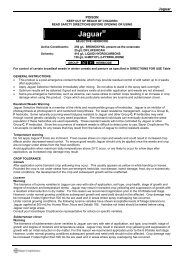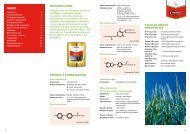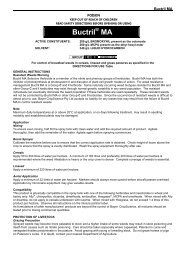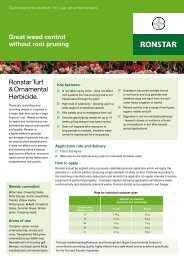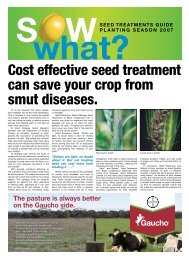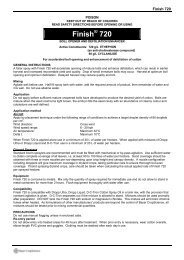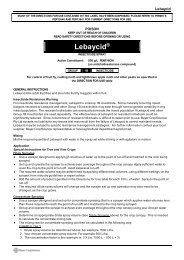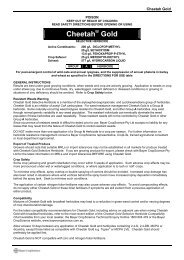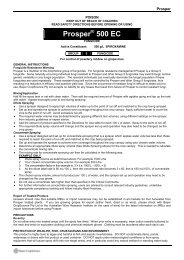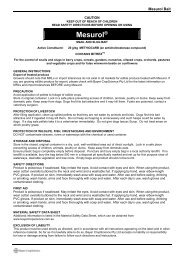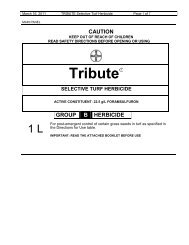Material safety data sheet - Bayer CropScience
Material safety data sheet - Bayer CropScience
Material safety data sheet - Bayer CropScience
You also want an ePaper? Increase the reach of your titles
YUMPU automatically turns print PDFs into web optimized ePapers that Google loves.
MATERIAL SAFETY DATA SHEET<br />
Date of Issue: August 25 th 2010<br />
1. IDENTIFICATION OF THE MATERIAL AND SUPPLIER<br />
Product name <strong>Bayer</strong> Chlorothalonil 500 SC Fungicide<br />
Other names None<br />
Product codes and<br />
pack sizes<br />
4952854 (20 L), 6472001 (60 L)<br />
Chemical group Chloronitrile<br />
Recommended use Fungicide for agricultural use<br />
Formulation Suspension concentrate (SC)<br />
Supplier <strong>Bayer</strong> <strong>CropScience</strong> Pty Ltd ABN 87 000 226 022<br />
Address 391 - 393 Tooronga Road, East Hawthorn<br />
Victoria 3123, Australia<br />
Telephone (03) 9248 6888<br />
Facsimile (03) 9248 6800<br />
Website www.bayercropscience.com.au<br />
Contact<br />
Emergency<br />
Development Manager (03) 9248 6888<br />
Telephone Number 1800 033 111 – Orica SH&E Shared Services<br />
2. HAZARDS IDENTIFICATION<br />
EMERGENCY OVERVIEW<br />
HAZARDOUS SUBSTANCE (see Risk phrases below) –DANGEROUS GOOD<br />
VERY TOXIC TO FISH AND AQUATIC ORGANISMS<br />
Hazard classification Hazardous (National Occupational Health and Safety Commission - NOHSC)<br />
Risk phrases R40 – Limited evidence of a carcinogenic effect<br />
R26 – Very toxic by inhalation<br />
R41 – Risk of serious eye damage<br />
R37 – Irritating to respiratory system<br />
R43 – May cause sensitisation by skin contact<br />
Safety phrases See Sections 4, 5, 6, 7, 8, 10, 12, 13<br />
ADG classification See Section 14.<br />
SUSDP classification 6 (Standard for the Uniform Scheduling of Drugs and Poisons)<br />
3. COMPOSITION / INFORMATION ON INGREDIENTS<br />
Ingredients CAS Number Concentration (g/L)<br />
Chlorothalonil [1897-45-6] 500<br />
Other ingredients including solvents, dispersant and water (non hazardous) 740<br />
<strong>Bayer</strong> Chlorothalonil 500 SC Fungicide Page 1 of 6
MATERIAL SAFETY DATA SHEET<br />
Date of Issue: August 25 th 2010<br />
4. FIRST AID MEASURES<br />
If poisoning occurs, immediately contact a doctor or Poisons Information Centre (telephone 13 11 26), and follow<br />
the advice given. Show this <strong>Material</strong> Safety Data Sheet to the doctor.<br />
Inhalation If inhaled remove to fresh air and keep at rest. Obtain medical advice.<br />
Skin contact Carefully remove contaminated clothing. Wash affected areas with soap and water. Seek<br />
medical aid if irritation persists.<br />
Eye contact Rinse eyes immediately with clean water for at least 15 minutes and obtain urgent medical aid.<br />
Ingestion Wash out mouth with water. Do NOT induce vomiting. Give a glass of water. Keep patient at<br />
rest and seek urgent medical advice as above.<br />
First Aid Facilities Ensure washing facilities, especially an eyewash station, are available.<br />
Medical attention Local contamination:<br />
Eye exposure may result in irritation, conjunctivitis and corneal opacity. Irritation may occur<br />
following skin contact or inhalation. Allergic type reactions can be expected. Treatment should<br />
be symptomatic after decontamination. Antihistamine or steroid creams, and/or systemic<br />
steroids may be helpful.<br />
Systemic poisoning:<br />
Symptoms following ingestion of a large amount may include depression, diarrhoea, irritation of<br />
the mouth, oesophagus and stomach. There is no specific antidote. Treat symptoms.<br />
5. FIRE FIGHTING MEASURES<br />
Extinguishing media<br />
Hazards from<br />
combustion products<br />
Precautions for fire<br />
fighters<br />
Hazchem code ▪3Z<br />
6. ACCIDENTAL RELEASE MEASURES<br />
Water spray, foam, dry chemical, carbon dioxide, sand<br />
In a fire, formation of hydrogen chloride, hydrogen cyanide, carbon monoxide and nitrogen<br />
oxides can be expected.<br />
Fire fighters should wear full protective gear, including self-contained breathing apparatus<br />
(AS/NZS 1715/1716). Keep unnecessary people away. If it can be done safely, remove intact<br />
containers from the fire. Otherwise spray unopened containers with water to cool. Bund area<br />
with sand or earth to prevent contamination of drains or waterways. Dispose of extinguishing<br />
agent and spillage safely later.<br />
Avoid contact with spilled material or contaminated surfaces. Do not smoke, eat or drink during the clean up process.<br />
Wear personal protective clothing and equipment as detailed in Section 8 PERSONAL PROTECTION. Keep people and<br />
animals away. Contain spill and absorb with earth, sand, clay, or other absorbent material. Prevent spilled material from<br />
entering drains or watercourses. Collect and store in properly labelled drums for safe disposal. Clean floor with a damp<br />
cloth and place it in the drum. Seal drums and label ready for safe disposal. Deal with all spillages immediately. If<br />
contamination of drains, streams, watercourses etc. is unavoidable, warn the local water authority.<br />
<strong>Bayer</strong> Chlorothalonil 500 SC Fungicide Page 2 of 6
MATERIAL SAFETY DATA SHEET<br />
Date of Issue: August 25 th 2010<br />
7. HANDLING AND STORAGE<br />
Handling<br />
Keep out of reach of children. Attacks eyes and skin. Avoid contact with eyes and skin. Do<br />
not inhale spray mist. Repeated exposure may cause allergic disorders. Sensitive workers<br />
should use protective clothing. When preparing spray and using the prepared spray wear<br />
cotton overalls buttoned to the neck and wrist, washable hat, elbow-length PVC gloves,<br />
goggles and disposable face mask. If clothing becomes contaminated with product or wet with<br />
spray remove clothing immediately. If product on skin, immediately wash area with soap and<br />
water. If product in eyes, wash it out immediately with water. After use and before eating,<br />
drinking or smoking, wash hands, arms and face thoroughly with soap and water. After each<br />
day's use, wash gloves, goggles and contaminated clothing.<br />
Storage Store in the closed, original container in a cool, well ventilated area. Do not store for prolonged<br />
periods in direct sunlight.<br />
Flammability Non-flammable<br />
8. EXPOSURE CONTROLS / PERSONAL PROTECTION<br />
Exposure standards<br />
Biological limit values<br />
Engineering controls<br />
Personal Protective<br />
Equipment<br />
There are no applicable NOHSC exposure standards.<br />
None allocated<br />
Control process conditions to avoid contact. Use in a well-ventilated area only.<br />
Eyes:<br />
Clothing:<br />
Gloves:<br />
Respiratory:<br />
9. PHYSICAL AND CHEMICAL PROPERTIES<br />
Appearance: Viscous off white to grey liquid suspension<br />
Odour: Characteristic<br />
pH: 6.0 to 8.0<br />
Vapour pressure: 0.076 mPa at 25 °C (chlorothalonil)<br />
Vapour density: Not available<br />
Boiling point:<br />
Freezing/melting<br />
> 100° C (water)<br />
point:<br />
Not available<br />
Solubility: Disperses in water<br />
Specific Gravity: Approximately 1.24 at 20 °C<br />
Flash Point:<br />
Flammability<br />
Not flammable<br />
(explosive) limits:<br />
Auto-ignition<br />
Not available<br />
temperature:<br />
Partition coefficient<br />
(octanol/water):<br />
Not available<br />
Safety goggles<br />
Cotton overalls buttoned to the neck and wrist and a washable hat<br />
Elbow-length PVC gloves<br />
Disposable face mask.<br />
Chlorothalonil: Log Pow = 2.92 at 25 °C<br />
<strong>Bayer</strong> Chlorothalonil 500 SC Fungicide Page 3 of 6
MATERIAL SAFETY DATA SHEET<br />
Date of Issue: August 25 th 2010<br />
10. STABILITY AND REACTIVITY<br />
Chemical stability Stable under normal conditions of use.<br />
Conditions to avoid<br />
Incompatible<br />
materials<br />
Hazardous<br />
decomposition<br />
products<br />
Hazardous reactions None<br />
Excessive heat<br />
11. TOXICOLOGICAL INFORMATION<br />
Oxidising agents, acids, alkalis<br />
In a fire, formation of hydrogen chloride, hydrogen cyanide, carbon monoxide and nitrogen<br />
oxides can be expected.<br />
POTENTIAL HEALTH EFFECTS<br />
Inhalation Very toxic if inhaled, however an unlikely route of exposure when handling the concentrate.<br />
Care should be taken to avoid inhalation of spray mist when spraying. Irritating to the<br />
respiratory tract.<br />
Skin contact Attacks skin. Allergic reactions in sensitive persons are possible.<br />
Eye contact Attacks eyes.<br />
Ingestion Low toxicity if swallowed, but will irritate the mouth, oesophagus and stomach lining.<br />
TOXICITY DATA<br />
Acute:<br />
Oral toxicity LD50 rat: > 5000 mg/kg (chlorothalonil)<br />
Dermal toxicity LD50 rabbit: > 5000 mg/kg (chlorothalonil)<br />
Inhalation toxicity LC50 rat (4 hour): 0.1 mg/L (chlorothalonil)<br />
Skin irritation Mild skin irritant (rabbit) (chlorothalonil)<br />
Eye irritation<br />
Severe eye irritant (rabbit) (chlorothalonil)<br />
Sensitisation Evidence in humans of contact dermatitis with repeated exposure.<br />
Chronic:<br />
In animal studies chronic administration of chlorothalonil caused liver and kidney damage. NOHSC have classified<br />
chlorothalonil in Category 3 – Possibly carcinogenic to humans.<br />
Chlorothalonil is not mutagenic, not teratogenic and did not produce reproductive effects in animal studies.<br />
Repeated exposure to this product may cause allergic disorders.<br />
<strong>Bayer</strong> Chlorothalonil 500 SC Fungicide Page 4 of 6
MATERIAL SAFETY DATA SHEET<br />
Date of Issue: August 25 th 2010<br />
12. ECOLOGICAL INFORMATION<br />
This product is very toxic to fish and aquatic organisms. It has a low toxicity to birds, bees and earthworms.<br />
DO NOT contaminate streams, rivers or waterways with the product or used containers.<br />
Ecotoxicity Chlorothalonil:<br />
Fish toxicity: LC50 (96 h) 59 µg/L bluegill sunfish (Lepomis macrochirus)<br />
LC50 (96 h) 47 µg/L rainbow trout (Onchorhynchus mykiss)<br />
Daphnia toxicity: LC50 (48 h) 70 µg/L water flea (Daphnia magna)<br />
Algal toxicity: EC50 (72 h) 5.1 µg/L (Navicula pelliculosa)<br />
EC50 (120 h) 210 µg/L (Selenastrum capricornutum)<br />
Bird toxicity: LD50 > 4640 mg/kg mallard duck<br />
Environmental fate,<br />
persistence and<br />
degradability, mobility<br />
13. DISPOSAL CONSIDERATIONS<br />
Chlorothalonil has low mobility or is immobile in soils. In aerobic and anaerobic soil studies the<br />
DT50 was 0.3 to 28 days (20° C). Stable to hydrolysis. Degradation is faster in biotic aquatic<br />
systems.<br />
When returnable container is empty or contents no longer required, return it to the point of purchase. For non-returnable<br />
containers, triple or (preferably) pressure rinse them before disposal. Add rinsings to spray tank. Do not dispose of<br />
undiluted chemicals on-site. If recycling, replace cap and return clean containers to recycler or designated collection<br />
point. If not recycling, break, crush or puncture and bury empty containers in a local authority landfill. If no landfill is<br />
available, bury the containers below 500 mm in a disposal pit specifically marked and set up for this purpose clear of<br />
waterways, desirable vegetation and tree roots. Empty containers and product should not be burnt. Dispose of waste<br />
product via a reputable disposal contractor to an approved landfill.<br />
14. TRANSPORT INFORMATION<br />
UN number UN 3082<br />
Proper shipping<br />
name<br />
ENVIRONMENTALLY HAZARDOUS SUBSTANCE, LIQUID, N.O.S (contains chlorothalonil)<br />
Class and<br />
Subsidiary Risk<br />
Class 9<br />
Packing Group Packing Group III<br />
Hazchem code ▪3Z<br />
Marine Pollutant Yes<br />
Note for Road and According to AU01, Environmentally Hazardous Substances in packagings, IBCs or any<br />
Rail Transport other receptacle not exceeding 500 kg or 500 L are not subject to the ADG Code<br />
15. REGULATORY INFORMATION<br />
Registered according to the Agricultural and Veterinary Chemicals Code Act, 1994<br />
Australian Pesticides and Veterinary Medicines Authority approval number: 45008<br />
<strong>Bayer</strong> Chlorothalonil 500 SC Fungicide Page 5 of 6
MATERIAL SAFETY DATA SHEET<br />
Date of Issue: August 25 th 2010<br />
16. OTHER INFORMATION<br />
Trademark<br />
information<br />
Preparation<br />
information<br />
None<br />
Replaces November 26 th 2009 edition.<br />
Reasons for revision: Hazards Identification, Fire fighting measures.<br />
This MSDS summarises our best knowledge of the health and <strong>safety</strong> hazard information of the product and how to safely<br />
handle and use the product in the workplace. Each user should read this MSDS and consider the information in the<br />
context of how the product will be handled and used in the workplace including in conjunction with other products.<br />
If clarification or further information is needed to ensure that an appropriate risk assessment can be made, the user<br />
should contact this company.<br />
Our responsibility for products sold is subject to our standard terms and conditions, a copy of which is sent to our<br />
customers and is also available on request.<br />
END OF MSDS<br />
<strong>Bayer</strong> Chlorothalonil 500 SC Fungicide Page 6 of 6



